15+ SAMPLE Financial Audit Checklist
-
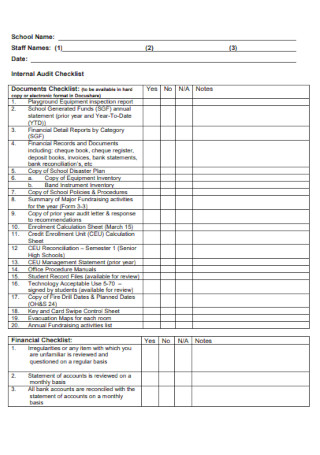
Internal Financial Audit Checklist Template
download now -
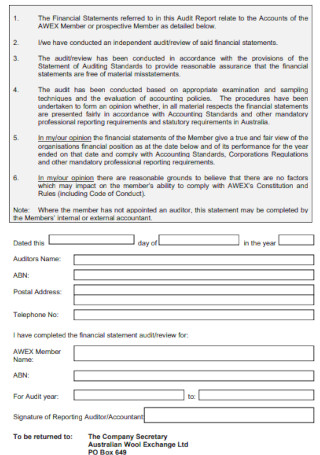
Financial Audit Checklist
download now -
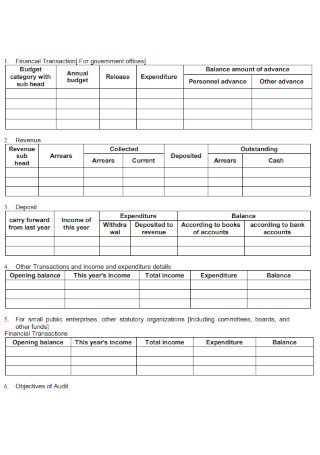
Financial-Audit Planning Checklist
download now -
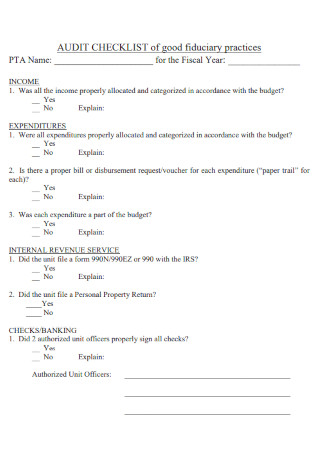
Financial Audit Management Checklist
download now -
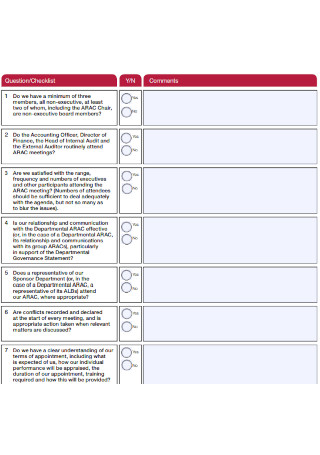
Financial Assessment Audit Checklist
download now -
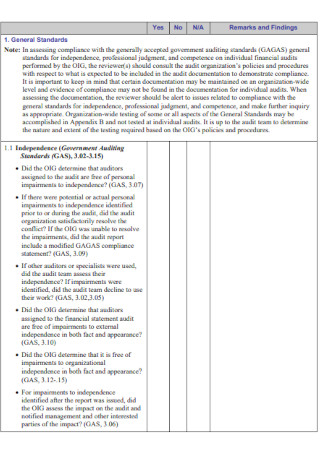
External Financial Audit Checklist
download now -
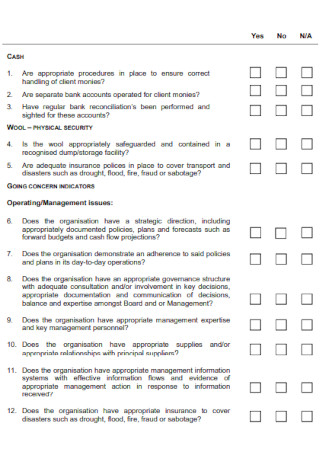
Monthly Financial Audit Checklist
download now -
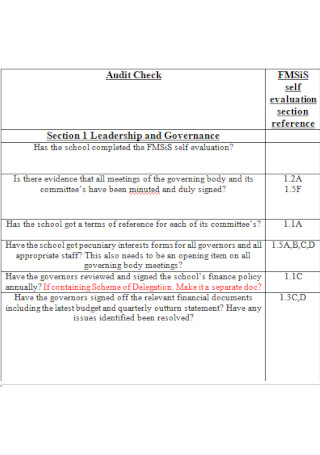
School Financial Audit Checklist
download now -
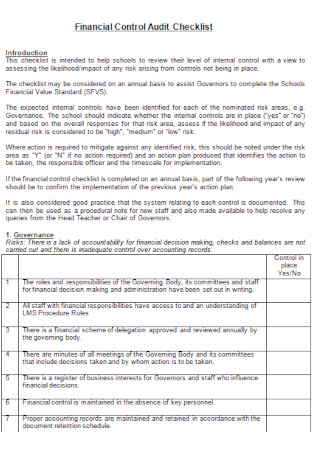
Financial Control Audit Checklist
download now -
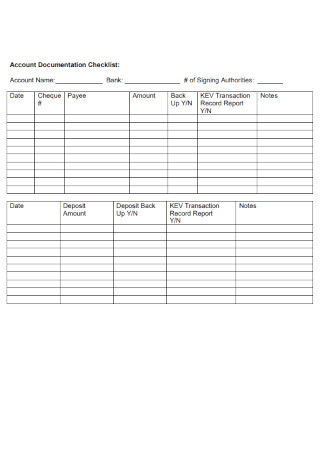
Internal Financial Audit Checklist
download now -
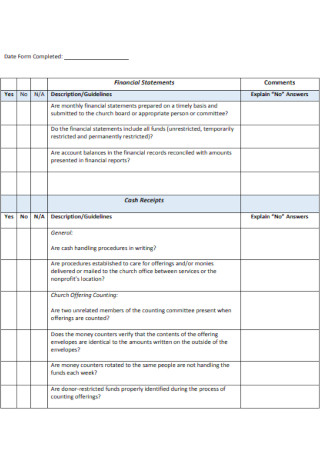
Annual Financial Audit Checklist
download now -
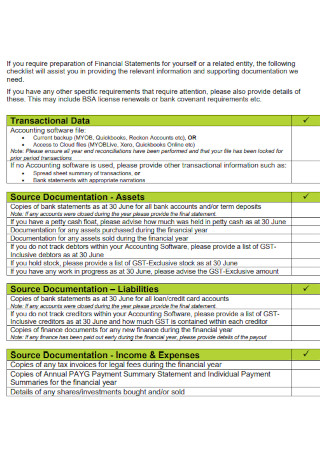
Financial Audit Statement Checklist
download now -
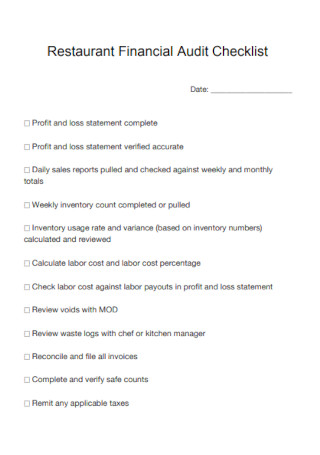
Restaurant Financial Audit Checklist
download now -
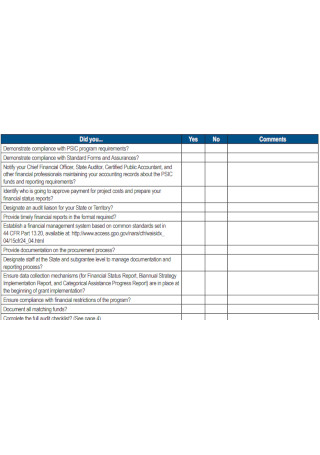
Financial Audit Preparation Checklist
download now -
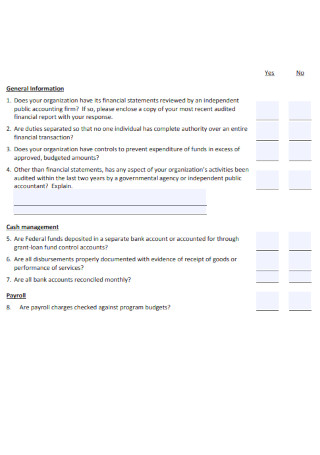
Mini Financial Audit Checklist
download now -

Financial Model Audit Checklist
download now
FREE Financial Audit Checklist s to Download
15+ SAMPLE Financial Audit Checklist
What Is Financial Audit Checklist?
Why Is Financial Audit Checklist Necessary?
What Are the Things to Include in a Financial Audit Checklist?
Tips in Creating a Financial Audit Checklist
How to Write Financial Audit Checklist
FAQs
What is an internal audit checklist?
What records are required for an audit?
What are the types of audits?
What Is Financial Audit Checklist?
To ensure that the audit is carried out effectively, a financial audit checklist should be utilized to compile a list of the many activities that need to be completed before the audit can be considered complete. Use this professional checklist template to quickly and easily construct a checklist for any task you need to complete. This template includes a ready-made file that is really basic and straightforward to utilize. Unbiased and objective evaluation of the financial reports and financial reporting methods of an organization or a business is performed by a financial auditing company. A checklist for the process is a tool that lists all of the items that need to be completed. With the help of this checklist example template, you can gain access to a similar file that will be of great use to you in completing your assignment.
Other templates are available on our website, and you can use them whenever you need them. They are as follows: business proposal, financial audit report, internal financial audit, external financial audit report, process audit checklist, non-disclosure agreement, contractor agreement, independent contractor agreement, bid proposal, non-compete agreement, and other similar templates are available. This post will not only provide you with templates but will also provide you with important information that you need to know in order to complete your template.
Why Is Financial Audit Checklist Necessary?
When it comes to streamlining your auditing and report-writing processes, using pre-made financial audit report templates can be really beneficial. The use of these downloadable templates, on the other hand, is entirely optional. What matters is that you, as an auditor, have devised an audit plan, carried it out with the utmost integrity and attention, and prepared a report about it that is consistent with your fundamental principles and beliefs. You may also come across reports on energy audits. It goes without saying that the utilization of pre-made financial audit report templates is just a bonus. Furthermore, they contribute to making your job easier. Use them at your discretion and only if you are already confident in your ability to produce a solid financial audit report without the assistance of these templates. You might also be interested in IT report templates. As a bonus, we would greatly appreciate it if you could forward this post to your colleagues and friends on social media or through your email distribution list.
What Are the Things to Include in a Financial Audit Checklist?
A financial audit checklist is nothing more than a comprehensive list that has been developed in advance. It enumerates the tasks that must be completed, and the tasks in the list are not required to be completed in any particular order. In a manner, checklists also act as a form of reminder, as they serve to remind us of what needs to be done and what still needs to be done in the future. Its use can aid in the improvement of efficiency and production by reducing the occurrence of errors and lapses.
1. Budgets and Financial Statements Are Two Types of Financial Statements
The budget and financial statements are two of the most significant items that should be included in a financial audit checklist, and they should be included together. The financial health of every firm is tracked and assessed through the use of budgets and financial statements, which are used by virtually every type and size of the organization. It is recommended that annual budgets for anticipated revenue and expenses be established at the start of each year and tracked on a monthly basis. The balance sheet, income statement, owners’ equity statement, and cash flow statement are the most crucial financial statements.
2. Revenue and Sales Costs Are Two Important Factors to Consider
Accounting professionals must conduct tests on revenue and cost-of-sales entries in the general ledger and the financial statements that follow the general ledger entries. These entries must first be authenticated by providing evidence of inventory shipment or service delivery before they may be created. Businesses will be able to declare regular long-term sales contracts as a result of this. Cost-of-sales entries should be accurately timed and cross-checked for accuracy with the corresponding revenue entries before being submitted.
3. Trial and Error Balance
The “trial balance” of a corporation is a snapshot of the values of all accounts taken at a specific point in time. It is recommended that audit methods be used to confirm the balances, with a special emphasis on reconciling the primary accounts. Accounts receivable and accounts payable balances must be supported by specific reports, which must be given in support of the balances. Inventory and fixed assets should be checked by item, quantity, and value throughout the year in order to ensure correctness. Periodic cycle counts should also be checked to ensure accuracy.
4. Documentation of Transactions
The general ledger is required to record all of the financial transactions that occur within the organization. It is essential that every transaction, whether it is documented in manual form or through an electronic system, be recorded on a regular basis with adequate information to determine who produced it and why.
5. Accounts Receivable
Accruals are required in order to establish balance sheet reserves for pending payments. Accruals must be established before balance sheet reserves may be established. In general, this comprises items such as the sums owed for salaries that are pending processing, sick-day earnings, bonuses, commission agreements, and other similar items that are due. Accruals for state, local, and federal taxes on property, sales, or income must also be financed in order to comply with legal requirements.
6. Bylaws and Minutes of Meetings
Bylaws enacted by the board of directors for the benefit of the company and its stakeholders should be documented and periodically reviewed in order to ensure that all directives are being followed. The minutes of executive meetings should also be reviewed to ensure that sufficient action has been taken to address any concerns that have arisen as a result of these meetings.
Tips in Creating a Financial Audit Checklist
The information in this article is intended for those who are looking for a more efficient method of creating their financial audit reports. Yes, these audit reports should be regarded seriously, as they are frequently utilized by large corporations, organizations, and even government entities to determine their financial health. Auditors must concentrate on their jobs—the actual auditing and report-writing process—and dedicate less time to the nitty-gritty details of preparing their internal audit reports, as explained in this article. So that you can complete your audit reports more quickly and enjoy this part of your job more, we’ve compiled a list of suggestions that you may use to make the process a little easier and more enjoyable. If you’re interested, take a look at the information below.
How to Write Financial Audit Checklist
Checklists were misunderstood in a variety of ways by many people. For starters, they believed that they were not as important as other types of documents. Second, they feel that the creation of such documents is not particularly difficult. To tell the truth, it’s the other way around in this case. Take, for instance, the house inspection checklist and the evaluation checklist as illustrations. If you are concerned that you will not make an audit checklist in the proper manner, you need not be concerned since we have supplied you with suggestions below that will undoubtedly assist you in producing an audit checklist successfully and efficiently.
Step 1: Take a Look at the Standards
You must force yourself to conduct qualitative research as soon as possible if you have been assigned the duty of creating something you are unfamiliar with. An intense course may be beneficial, but it is not recommended. Making yourself grasp the basic objective of generating an audit checklist will provide you with a hint as to how to proceed with the subsequent elements in the process.
Step 2: Make a Decision on the Audit Subject
Using your task checklist as a guide, begin your composition by identifying the primary subject of your intended audit. Create a focus statement to go along with the main issue of your checklist so that it serves as a constant reminder of your goals and ambitions.
Step 3: Subheadings Should be Created
Headings and subheadings are used to organize a project overview. This will make it easier for you to cognitively grasp what you need to develop and what you need to search for. In other words, it prepares you to write technical documents that are effective. In addition, when creating a checklist, you should use the same guidelines.
Step 4: Describe the Header and Subheads in Detail
It is certain that creating a header and subhead will provide you with a better understanding of the issues that you must consider. However, including brief descriptions of each of them would be greatly beneficial. If you take a look at website headers and blog headers, you will notice that their descriptions successfully present the subject matter to viewers.
Step 5: Topics for Auditing Should be Listed
Following that, you’ll see a list of the audit subjects you’ll be reviewing. It is possible to create strategic planning surveys, names, or phrasal descriptions for these themes. These descriptions will make it easier to write an inspection report after you have read them. It is not required to create boxes on the sides of each object, but many people do so.
Step 6: Duplicate and Copy-Edit Your Work
When you’ve finished your checklist, double-check to see if there are any mistakes on it. If this is the case, they should be corrected as soon as possible. Also, inquire with your colleague’s auditors to see if they have any additional items to add. These will help to make your process document more detailed and comprehensive. Once this is completed, make sure to create a duplicate of your data inventory for safety.
FAQs
What is an internal audit checklist?
An internal audit checklist helps assess if the organization’s quality management system standards have been effectively implemented and maintained.
What records are required for an audit?
An auditor will need information on the trial balance, new fixed asset purchases with invoices, loan statements, and stock subscriptions, among other things.
What are the types of audits?
These include external, internal, and IRS audits. External audit refers to audits conducted by third parties. Internal audits are the complete opposite. IRS audits, on the other hand, are a series of checks on taxpayer transactions.
Companies’ management systems, document control, and compliance issues have all demonstrated the value of financial audit checklists in their respective fields. They make certain that all procedures in all departments, including the administration department, the manufacturing department, customer service, and many others, are properly inspected before they are implemented. Depending on what has to be reviewed, such documents might take on a variety of different shapes and sizes.
